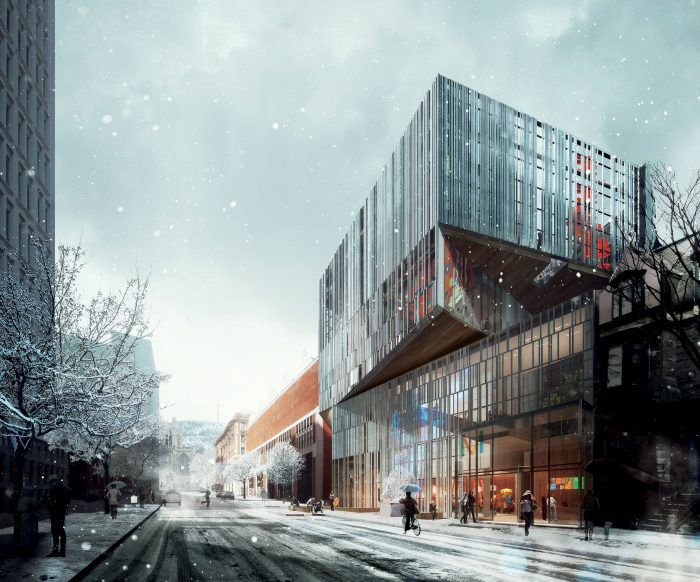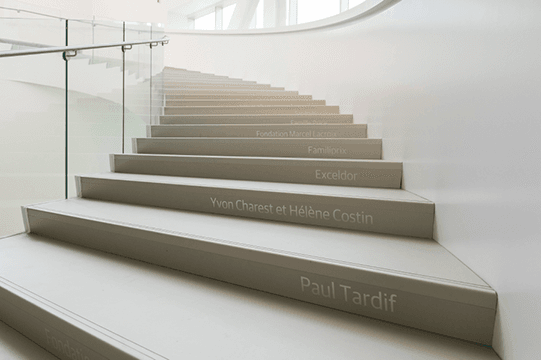
Montage photographique montrant le futur Pavillon pour la paix du Musée des beaux-arts de Montréal.
Partnership Development
Museum Collections and the Event-Driven Imperative
2014-2018
For the first time, the Museum Collections and the Event-Driven Imperative Partnership Development brought together museums and universities in a co-production of knowledge on the event-related uses of collections.
Project Description
For the first time, the Museum Collections and the Event-Driven Imperative Partnership Development brought together museums and universities in a co-production of knowledge on the event-related uses of collections. The Partnership Development involves principal investigator Johanne Lamoureux (full professor, Université de Montréal), and investigators Mélanie Boucher (full professor, Université du Québec en Outaouais) and Marie Fraser (full professor, Université du Québec à Montréal); three partner museums (the Musée d’art de Joliette, the Montreal Museum of Fine Arts, and the Musée national des beaux-arts du Québec); as well collaborators Elitza Dulguerova (lecturer, Université Panthéon-Sorbonne, Paris I), Reesa Greenberg (art historian and independent scholar), and Laurier Lacroix (professor emeritus, Université du Québec à Montréal).

The rhythm of museums is now regulated by an event-driven imperative. But what constitutes an event in the particular field of museology? For a long time, events have been associated with the production of special exhibitions or ephemeral events, the number of which is increasingly significant, and the formats growingly diverse. The strength of this first project, Museum Collections and the Event-Driven Imperative, is to ask the following question: when events enter museums, what are the consequences of this new amplification on the collections, on the narrative of art that unfolds in their presentation, and on the heritage conception of works? The public life of museums, like that of most cultural institutions, is underpinned by what we call the event-driven imperative. This expression does not designate a set of punctual circumstances around singular events, but a system, a scheme, by which the reputation and the survival of cultural institutions are inextricably linked to their “capital of visibility,” as Nathalie Heinich sees it, and to their capacity to capture the attention of media platforms. We have thus grouped together under this heading a set of possible actions, designated as museum strategies, and we are attempting, in partnership with museums that are interested in and concerned about this situation, to reflect on the manifestations of these strategies and their impact on collections. Our partners, the Musée d’art de Joliette, the Montreal Museum of Fine Arts, and the Musée national des beaux-arts du Québec, are three institutions whose status and collecting mandate vary. However, a common set of circumstances informs their participation in this project: a significant donation, an architectural expansion, and a redeployment of collections.
Thus, beginning in 2014, we began to explore with these three museums, new experiments in the valorization of their collection. Abandoning or reworking the chronological and stationary course of the art history textbook in favour of exhibitions of the collection compressed in time and welcoming anachronistic intrusions, thematic presentations, carte blanche projects (from contemporary art artists, curators, personalities, or members of the public), live arts events in the permanent galleries or singularization of works, the art museums have promoted the implementation of novel uses of their collection. These ways of doing things introduce previously unexplored modalities in the conception and treatment of collections. They significantly reshape three parameters: their relationship to time, which shifts from long duration to a more convulsive event-based time; their relationship to space, which promotes the display of pieces outside of the series or predictable adjacencies in which they are usually showcased; and their relationship to use, insofar as certain strategies aim to think of the collection in terms of other registers that are more closely linked to people (from museum professionals to marginalized groups) than to encyclopedic, national, or historical paradigms.
Reference:
This text is a revised version of “Penser l’actualité des collections : une introduction” in Mélanie Boucher, Marie Fraser, and Johanne Lamoureux (eds.) (2023), Réinventer la collection : l’art et le musée au temps de l’évènementiel. Québec: Presse de l’Université du Québec.

Objectives
The Museum Collections and the Event-Driven Imperative Partnership Development brings together the museum and the university in a co-production approach to knowledge about the practices surrounding the event uses of collections by pursuing four objectives:
- To showcase collections in the current context of an almost exclusive craze for exhibitions.
- To reflect on the consequences, for the heritage dimension of the collections, of these new uses for events.
- To produce new knowledge on this new question based on the inventory of these new museum practices.
- To foster an institutional de-compartmentalization between the two hubs that support the discipline of art history, namely the museum and the university, and, in this respect, to adapt the training of researchers to the dual reality of the professional environments where they are likely to work.
Theoretical results
The conducted survey showed that while our initial hypothesis was well founded, it deserved to be broadened. For if the irruption of events within collections has given rise to new uses, these are more numerous and varied and have come to form a constellation of strategies that impel current and social concerns into the traditionally stationary time of collections and impact all the stages of life of the collection object. Indeed, the study of different uses indicates that the event-driven imperative has quickly become the occasion for a reflexive turn in the institution, the modalities of which go beyond (or even in some cases ignore) simple media amplification and communicational visibility.
